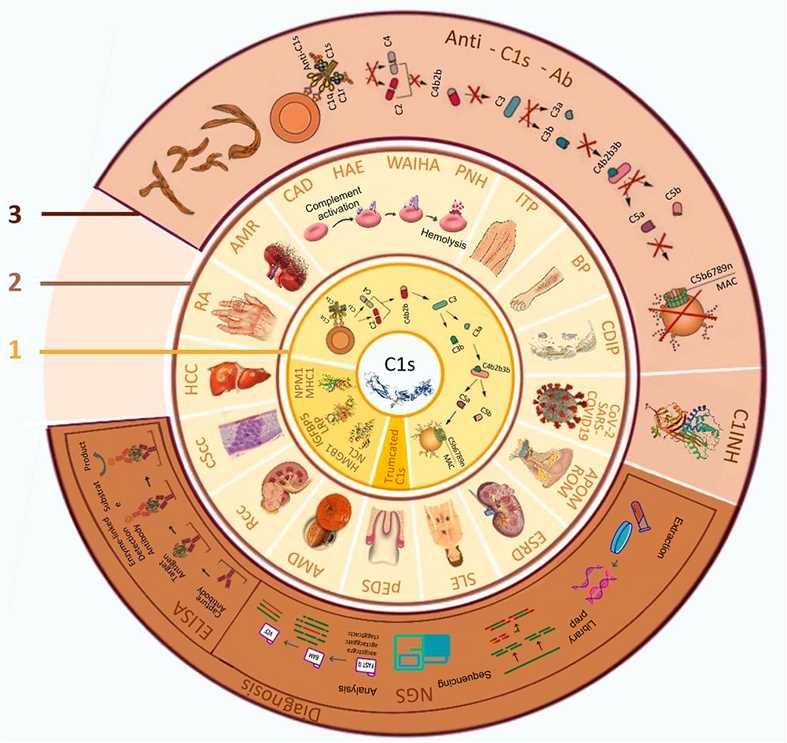As a global leader in the drug discovery and complement therapeutic field, Creative Biolabs is dedicated to providing a full range of biotherapeutics development services. We have well-established antibody engineering platform, protease inhibitor platform, and drug discovery platform, and are fully equipped to partner with our clients who are doing or may have the desire to work on complement systems for drug discovery and validation.
The Classical Pathway
As part of the innate immune system, the complement system is the biological cascade that aids or “complements” the ability of antibodies to remove pathogens or mark them for the elimination by other cellular components. There are three different pathways for the complement system, the classical pathway, the lectin pathway, and the alternative pathway. The classical pathway is linked to the adaptive immune system. It is initiated by the C1 complex recognizing the antigen-antibody complex. C1s is encoded by the C1S gene. C1s is cleaved by C1r, another component of the C1 complex, to form the activated form of C1s. The activated C1s cleaves complement C2, transforming C2 into C2a and C2b. C2a binds C4b to form C3 convertase leading to the formation of the membrane attack complex and the elimination of the target.

Fig. 1 The structure of C1s.1, 3
-
Function
In the classical pathway of the complement system, when in the presence of calcium, the activated C1s forms a complex with C1r and C1q, resulting C1q-C1r2-C1s2 complex.
-
Regulation
C1s is neutralized by C1-inhibitor (C1-INH) which acts as a member of the superfamily of serine protease inhibitor that regulates the complement system, coagulation, and inflammation. In the classical pathway of the complement system.
-
C1s Related Disease
C1s protein is associated with the periodontal Ehlers-Danlos syndrome (pEDS) and Hashimoto Disease.
-
Periodontal Ehlers-Danlos syndrome is an autosomal dominant disorder characterized by severe early-onset periodontal disease in conjunction with the features of Ehlers-Danlos syndrome. It is characterized by articular hypermobility, skin hyperextensibility, and tissue fragility. Mutations in the collagen-related genes, the collagen-processing enzymes lysyl hydroxylase and procollagen N-peptidase have been found to underlie several Ehlers-Danlos syndromes. More importantly, mutations in C1R and C1S genes lead to pEDS.
-
C1s is also linked to Hashimoto Disease which is an autoimmune disorder that attacks the body’s own cells and organs.
Creative Biolabs' outstanding crew are confident in providing high-quality biotherapeutics development services based on the complement system. We offer turn-key or ala carte services customized to our client’s needs. Our service takes away the cost and effort of setting up assays in your laboratory and gets rapid results with minimal assay variation. If you are interested in our platform or you are calling for our services, please contact us for detailed information.
Published Data
 Fig.2 C1s: biological roles, associated disorders, and implications for diagnosis and therapy.2,3
Fig.2 C1s: biological roles, associated disorders, and implications for diagnosis and therapy.2,3
The complement system serves as a crucial link between innate and adaptive immune pathways, ensuring physiological equilibrium. Central to this system is the C1 complex, comprising C1q, C1r, and C1s, which activates the classical complement pathway. C1s deficiency is linked to early-onset systemic lupus erythematosus and an increased risk of bacterial infections. Conversely, gain-of-function mutations in C1r and C1s can cause periodontal Ehlers-Danlos syndrome. Given C1s’s role in inflammation, autoimmunity, and cancer, it’s a promising diagnostic and therapeutic biomarker. Therefore, advanced methods to measure C1s levels and activity are essential. Various small molecules, peptides, and monoclonal antibodies targeting C1s have been developed, including a US FDA-approved antibody for cold agglutinin disease, a type of autoimmune hemolytic anemia.
References
-
Kapferer-Seebacher, Ines, et al. "Periodontal Ehlers-Danlos syndrome is caused by mutations in C1R and C1S, which encode subcomponents C1r and C1s of complement." The American Journal of Human Genetics 99.5 (2016): 1005-1014.
-
Ye, Jun, et al. "Complement C1s as a diagnostic marker and therapeutic target: Progress and propective." Frontiers in immunology 13 (2022): 1015128.
-
Distributed under Open Access license CC BY 4.0, without modification.
Related Product
Questions & Answer
A: Several approaches are being explored to target C1s. These include the development of small molecule inhibitors, monoclonal antibodies, and other biologics that specifically bind to and inhibit C1s activity. Additionally, strategies to modulate C1s expression or activity through gene therapy or RNA interference techniques are also being investigated.
A: Yes, targeting C1s has shown promising results in various diseases and conditions. For example, in paroxysmal nocturnal hemoglobinuria (PNH), ravulizumab, a C1s inhibitor, has demonstrated significant clinical benefits by reducing hemolysis and transfusion requirements. Additionally, C1s inhibitors have shown potential in autoimmune diseases like systemic lupus erythematosus (SLE), where complement dysregulation plays a role in disease pathogenesis.
A: C1s inhibitors specifically target the initiation step of the classical complement pathway and can effectively modulate complement activation. Compared to broad-spectrum complement inhibitors, targeting C1s offers a more selective approach, potentially minimizing off-target effects and preserving other important functions of the complement system.
For Research Use Only.
Related Sections:


 Fig.2 C1s: biological roles, associated disorders, and implications for diagnosis and therapy.2,3
Fig.2 C1s: biological roles, associated disorders, and implications for diagnosis and therapy.2,3